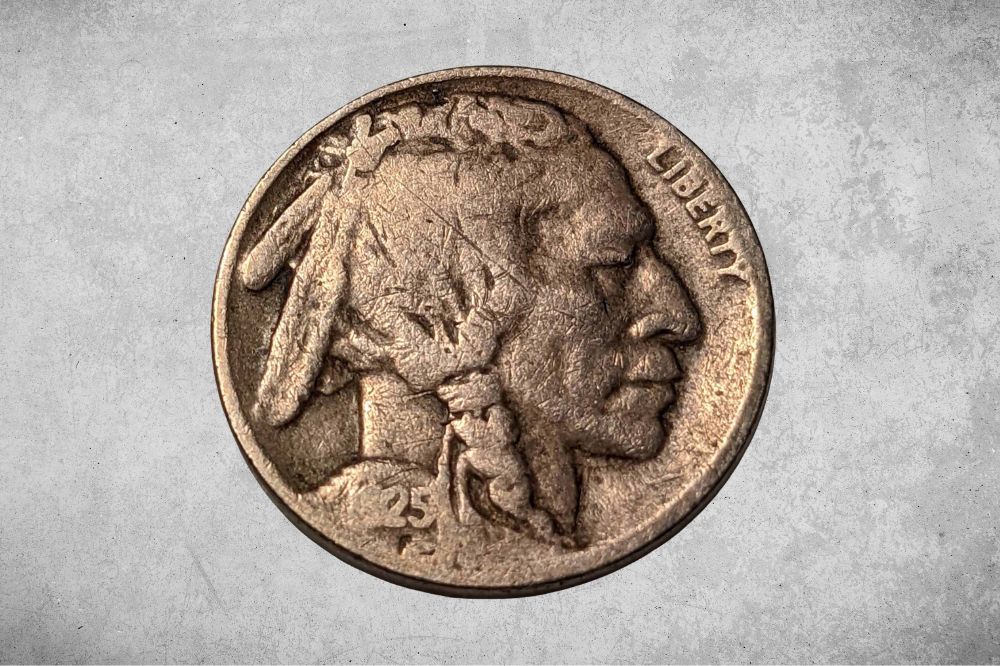The buffalo nickel was not the first five-cent coin minted by the American government, but it’s perhaps one of the most popular. Commonly known as the Indian head nickels, these coins are at the top of most collectible specimens in American history.
They stand out thanks to their symbolism connected with early 20th-century America. Numismatists also love them because of their unique, beautiful design and rarity, especially in uncirculated conditions.
Here, we will explore the 1925 Buffalo nickel, including its details, value, history, grading, and errors.
1925 Buffalo Nickel Details

- Category: Buffalo Five Cents
- Mint: Philadelphia, Denver, and San Francisco
- Mintage: 49,271,100
- Designer: James Earl Fraser
- Metal Composition: Copper–Nickel
- Fineness: 75
- Diameter: 2mm
- Weight: 5 grams
- Edge: Plain
Designed by James Earle Fraser, the 1925 buffalo nickel is a beautiful coin weighing only 5 g or 0.1764 ounces. It’s made of 75% copper and 25% nickel. This metal blend gives the nickel its unique color and feel.
The Obverse Side
On the obverse side, the 1925 Buffalo nickel features a portrait of a Native American chief wearing a headdress with feathers.
According to the coin’s designer, he wanted to create something that reflects the American culture. And what better way to achieve this than fitting a visage of a North American Indian on the obverse side?
What is interesting, the profile of the Native Indian does not belong to a specific person. Instead, the sculptor combined several characteristics of Indian chiefs, including Iron Tail, Two moons, and Big Tree. Because of this, the obverse side of the nickel appears realistic and detailed.
On the top-left side of the portrait, the word LIBERTY is engraved. The date falls on the shoulder of the Native American.
The Reverse Side
The reverse side of the coin depicts an American bison standing on a raised embankment. The Bison symbolizes the native beauty of the Wild West.
Coin collectors believed Fraser identified a bull bison named Black Diamond that lived in the Central Park Zoo in New York as the primary model of the reverse. However, there’s limited information to support this claim.
Fraser believed the Buffalo was the perfect choice to represent the American Spirit and showcase the wildlife that inhabited the West. Additionally, it symbolized strength and resilience.
Above the Bison, you can see the words UNITED STATES OF AMERICA extending along the coin rim. Just below AMERICA lies the motto E PLURIBUS UNUM, which means “One from many”. As for the FIVE CENTS denomination, it falls at the bottom of the bull.
Although many people loved this design, it brought about many minting issues. The reason was, it was hard to make a matrix containing all the coin’s details. For example, the production date and Five cents denomination deteriorated quickly.
Also Read: 15 Most Valuable Nickels Worth Money
1925 Buffalo Nickel Value Chart
| Mint Mark | Good | Very Good | Fine | Extremely Fine | Uncirculated |
| 1925 “no mint mark” Buffalo Nickel | $3 | $5 | $7 | $25 | $35 |
| 1925 “D” Buffalo Nickel | $20 | $35 | $45 | $195 | $270 |
| 1925 “S” Buffalo Nickel | $7.50 | $15 | $35 | $200 | $275 |
1925 Buffalo Nickel Value and Varieties Guide
1925 “No Mint Mark” Buffalo Nickel Value
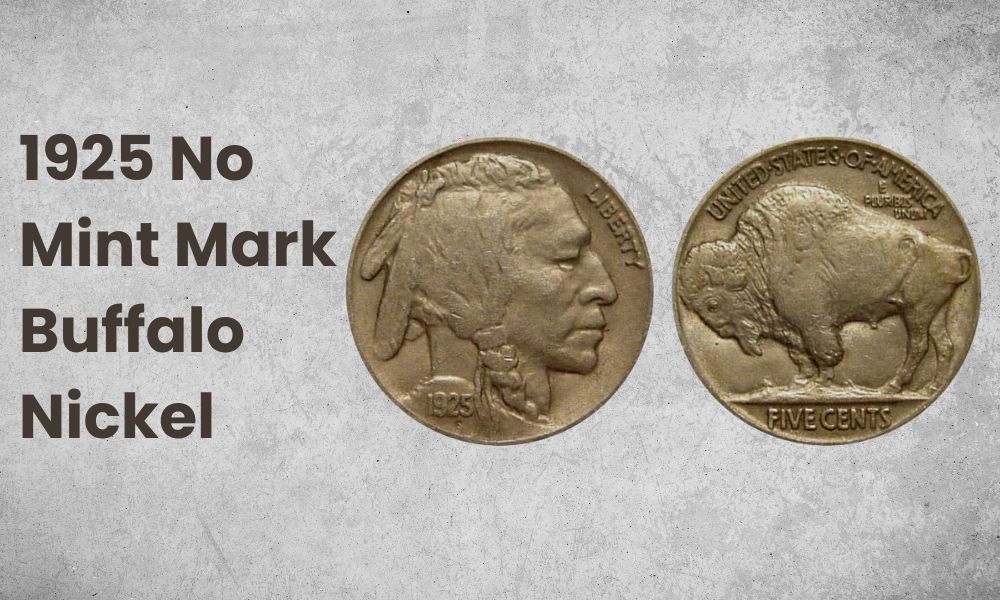
- Type: Buffalo Nickel
- Edge: Plain
- Mint Mark: n/a
- Mintage: 35,565,100
- Place of Mintage: Philadelphia
- Year of Minting: 1925
- Face Value: $0.05
- $ Price: $3 to $17,500
- Designer: James Earl Fraser
In 1925, the mint in Philadelphia struck more Buffalo nickels than any other mint. It produced about 35,565,100 Buffalo nickels.
Although the facility produced the best 1925 buffalo nickels, they had a weak appearance. Most coins had their first two numerals of the date being less fully raised. As a result, the date deteriorated once the coins entered circulation.
This happened because the mint’s engraving department failed to create an obverse master dies free from issues. It lacked clarity and was doubled on the left hair ribbon. This affected the overall striking quality of all 1925 coins minted.
All the 1925 nickels minted in Philadelphia had no mint mark, like all the coins produced at the facility during that period. Nevertheless, some collectors value specimens minted in this city because of their historical significance and connection to the oldest mint in America.
A 1945 Buffalo nickel in good condition costs around $3. Coins in very good or extremely fine condition can sell anywhere from $5 to $25. However, this value rises to $35 for uncirculated coins. Those in pristine condition and higher mint state, like MS67, can cost $5,000 to $17,500.
1925 “D” Buffalo Nickel Value
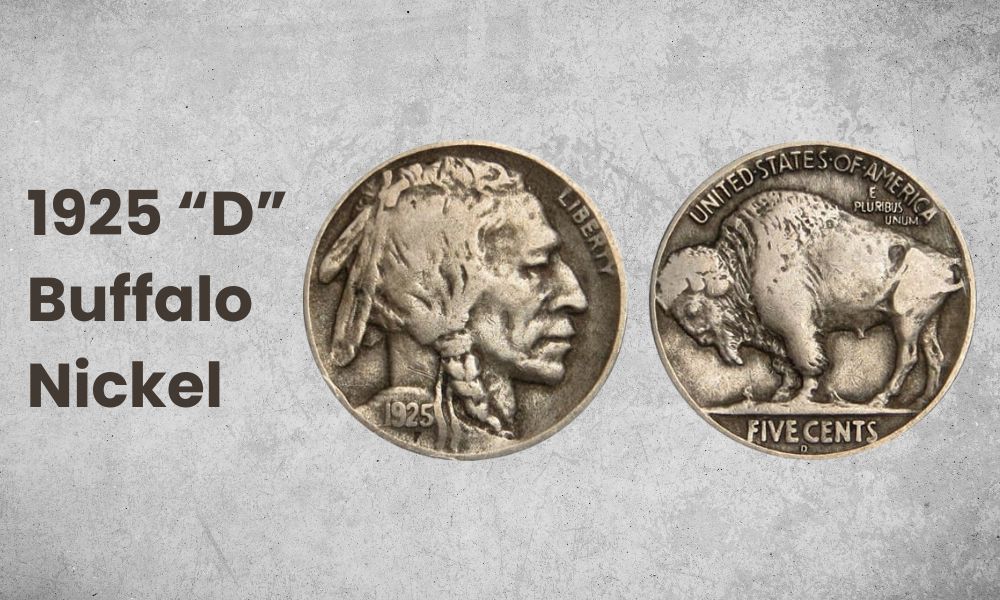
- Type: Buffalo Nickel
- Edge: Plain
- Mint Mark: D
- Mintage: 4,450,00
- Place of Mintage: Denver
- Year of Minting: 1925
- Face Value: $0.05
- $ Price: $10 to $12,000
- Designer: James Earl Fraser
The Denver mint struck 4,450,000 Buffalo nickel coins in 1925. The coin produced here had a small “D” mint mark on the reverse side below the denomination.
It seems all the minting facilities in 1925 encountered some trouble. For example, the Denver mint used worn and eroded dies, resulting in coins with poor luster. Besides, the Bull’s forehead and horn showed some signs of weakness.
The strong value across all 1924 D nickel grades reflects the popularity of this coin’s series and the scarcity of high-quality specimens.
A good quality circulated 1925-D nickel can cost between $10 and $195. On the other hand, mint-state coins can sell for as much as $12,000.
1925 “S” Buffalo Nickel Value
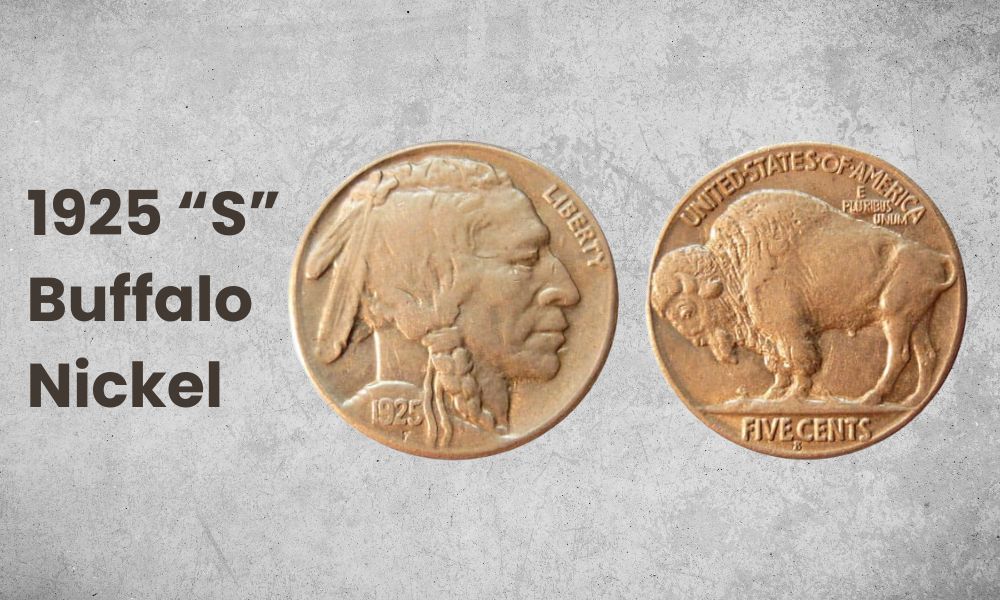
- Type: Buffalo Nickel
- Edge: Plain
- Mint Mark: S
- Mintage: 6,256,000
- Place of Mintage: San Francisco
- Year of Minting: 1925
- Face Value: $0.05
- $ Price: $3 to $50,000
- Designer: James Earl Fraser
Like the other mints, the San Francisco mint facility faced several challenges in the 1920s that might have led to the poor-quality coins produced. Such issues include underpaid federal workers, low morale, and heavily worn-out dies.
In 1925, the mint produced only 6,256,000 Buffalo mint coins with the “S” mint mark. However, these 1925 nickels are arguably the worst of the Buffalo series.
Most had weak strikes and mismatched obverse and reverse sides, such that one side looked new and the other old. Nonetheless, a few high-grade 1925-Buffalo coins exist. These usually fetch a high price.
As for the values, a 1925-S Indian nickel in good condition can be worth between $5 and $7.50. Extremely fine coins can cost $200 to $500. However, higher-grade specimens can fetch an impressive price of $36,000 or even $50,000.
Also Read: Top 110 Most Valuable Nickels Worth Money
1925 Buffalo Nickel History
In 1904, President Theodore Roosevelt voiced his dissatisfaction with the design of American coinage. As a result, the mint hired sculptor Augustus Saint-Gaudens to re-design all the coins.
But the sculptor only designed the eagle and double eagle on the gold coins before his death in 1907. Other artists designed the cent-quarter eagle and the double eagle. These coins got introduced into circulation in 1909.
Luckily, the Liberty Head nickel (designed by Charles. E Barber) introduced in 1883, had been in circulation for about 25 years. As such, it was due to a re-design.
Frank Leach, US Mint Director, instructed Chief Engraver, Charles. E Barber to create a new design for the nickels. The new design featured American first president, George Washington. However, the Mint never released the nickels since Leach left office and got replaced by Abram Andrew.
Under Andrew’s administration, sculptor James Earle Fraser, an assistant to Saint-Gaudens, got hired to replace the design of the cent. But in 1911, George Roberts replaced Andrew as the new Mint Director. Initially, George favored a coin design featuring Abraham Lincoln.
However, Fraser introduced a new coin design depicting a Native American on the obverse side and Bison on the reverse side. Although the approval for Fraser’s design took time, the secretary gave the sculptor the go-ahead in July 1912.
By June 1912, Fraser finished the models and electrotypes. Production for the Buffalo coin series began in February 1913. A few coins got minted and distributed to the Native American Chiefs who took part in creating the design.
In March 1913, the Buffalo nickels entered circulation and gained lots of praise from Americans who believed the coins represented American spirit and themes. Over the years, the Indian Head nickels saw many changes. For instance, the word LIBERTY was moved slightly and given more emphasis in 1916.
However, this coin series had a lot of issues than Liberty head nickels. The dies were being used up quickly and the engraving department struggles to create new dies to meet production. In addition, the date and denomination on the coin faded within a few months of circulation, making the nickel illegible.
The issue with die life and weak striking persisted in every Buffalo coin series, even the 1925 Buffalo nickels. Nevertheless, the nickels were struck by tens of millions at three U.S. mint locations: Philadelphia, Denver, and San Francisco.
After 25 years in production, the Jefferson nickel replaced the Indian Head Nickel in January 1938.
Also Read: Top 19 Most Valuable Jefferson Nickels Worth Money
1925 Buffalo Nickel Grading
It’s important to note that 1925 Buffalo nickel grading depends on the coin’s condition, rarity, and unique features. Below are a few grades used to describe the state of an Indian Head Nickel:
- Good (G): The nickel is in poor condition with signs of significant wear and damage. Some details are barely visible, with the date and denomination being faded.
- Fine (F): The grade refers to coins with signs of wear from circulation. They have several scratches on the surface, but some design details are still visible.
- Extremely Fine (EF or XF): The 1925 Buffalo nickel displays a few scratches on the surface, but it retains its design details and original luster.
- Uncirculated (UNC): An uncirculated coin has never entered circulation. It has no signs of wear and still keeps its original luster.
1925 Buffalo Nickel Error
1. 1925 Buffalo Nickel Clipped Planchet Error
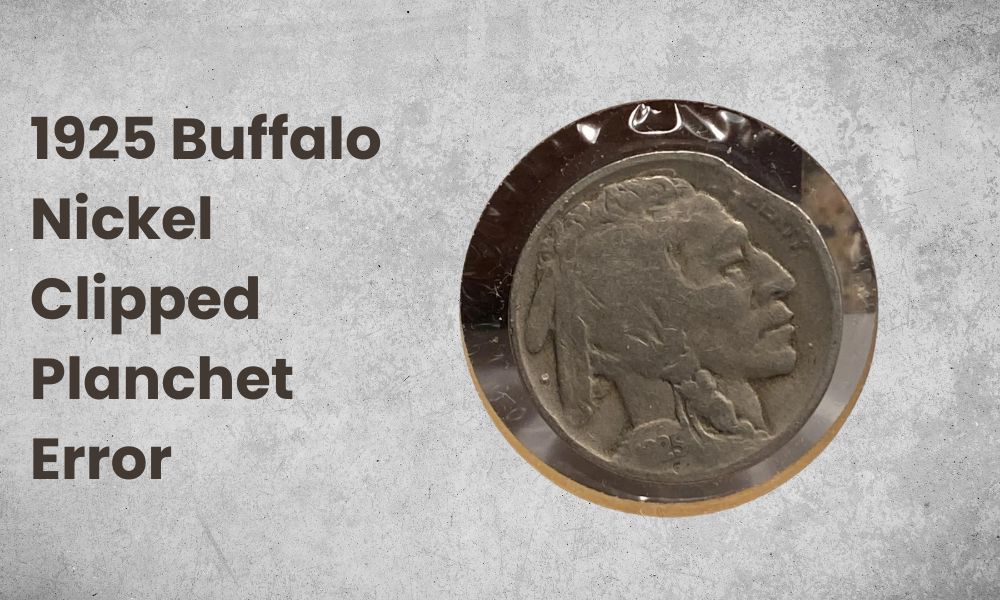
A clipped planchet error happens when the blank planchet strip is not cut properly or has a missing piece. When this blank sheet gets struck with the dies, the resulting coins will have a curved area of metal missing.
In the 1925 Buffalo Nickel, the severity of this error can vary, from a small clip to a significant part of the coin’s edge missing. One such coin, with a 4% clipped planchet, sold for $195.
2. 1925 Buffalo Nickel Off-Center Error
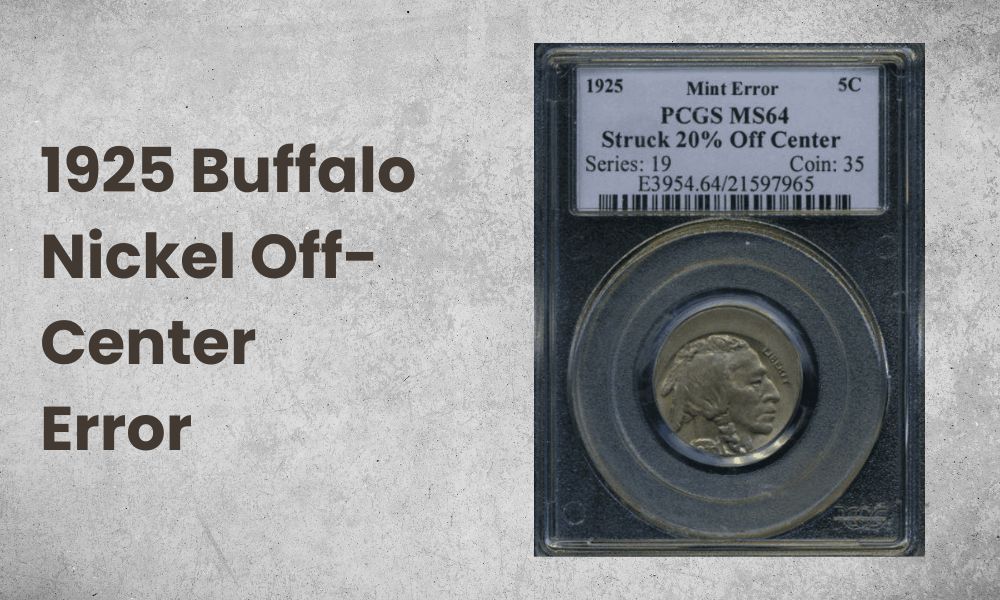
The off-center error refers to an inaccuracy made during the minting process. It occurs when the dies are not centered or aligned correctly, causing the nickel’s design to deviate from the center.
Like clipped planchet error, the degree of the off-center varies in 1925 nickels. Some coins can have 5% off-center, while others can have 50% off-center. Generally, the higher the degree of off-center in a coin, the more valuable it will be.
A 1925 Buffalo nickel with 5% off-center can sell for $575. Those with 25% off-center can even reach $900.
3. 1925 Buffalo Nickel Rotated Reverse Error
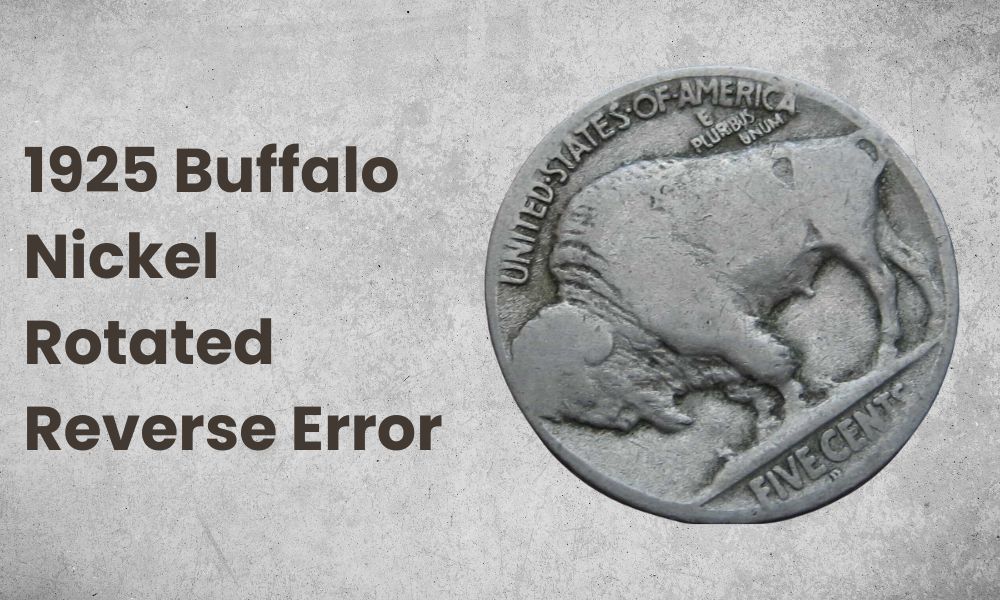
Another error worth checking out is the rotated reverse error. The error happens when the reverse side die spins around its vertical axis, resulting in a coin with a rotated reverse.
The rotated reverse error can increase the value of a coin significantly since it’s a rare occurrence. However, the coin’s value will depend on its state, the severity of the error, and demand among collectors.
A 1925 Buffalo nickel with a rotated reverse can sell for $800 or more.
4. 1925 Buffalo Nickel Struck on a Ten Cent Silver Planchet error
In this error, the 1925 Buffalo nickel gets struck on a ten-cent silver planchet instead of a five-cent planchet. The error results in a 1925 nickel with a different metal composition, luster, and weight.
Since this error is quite rare, the coin can fetch a huge price tag. Some coins can sell for as much as $4,800.
1925 Buffalo Nickel FAQ
How much is a 1925 Buffalo Nickel Worth?
Currently, circulated 1925 Buffalo nickels cost anywhere from $3 to $200. But mint state coins in pristine conditions can sell for upwards of $275 or $20,000, depending on the rarity.
Where is the mint mark on the 1925 Buffalo Nickel?
The U.S. government minted 1925 Buffalo nickels in three locations: Philadelphia, Denver, and San Francisco. The Philadelphia mint added no mint mark on their coins. However, nickels from Denver had a “D” mint mark, and those from the San Francisco mint came with the “S” mint mark.
Are Buffalo nickels pure silver?
The Civil War of 1861 to 1865 forced people to hoard silver and gold coins. As a consequence, the US mint didn’t have enough silver to create coins and make up for the money shortage.
As a solution, they made a new metal composition for the nickels: 75% copper and 25% nickel. This precious metal made it possible to conduct daily trade in goods and services.
That said, Buffalo nickels consist of copper and nickel. They don’t contain any silver.
